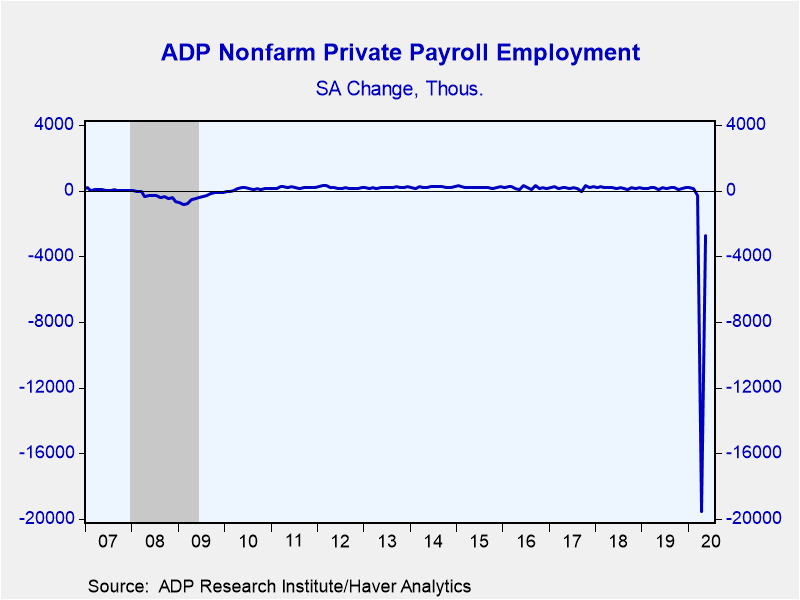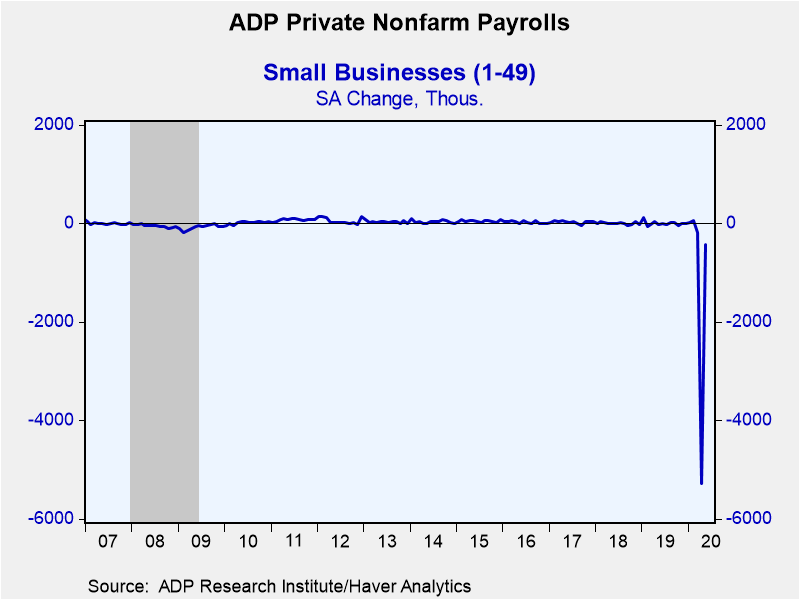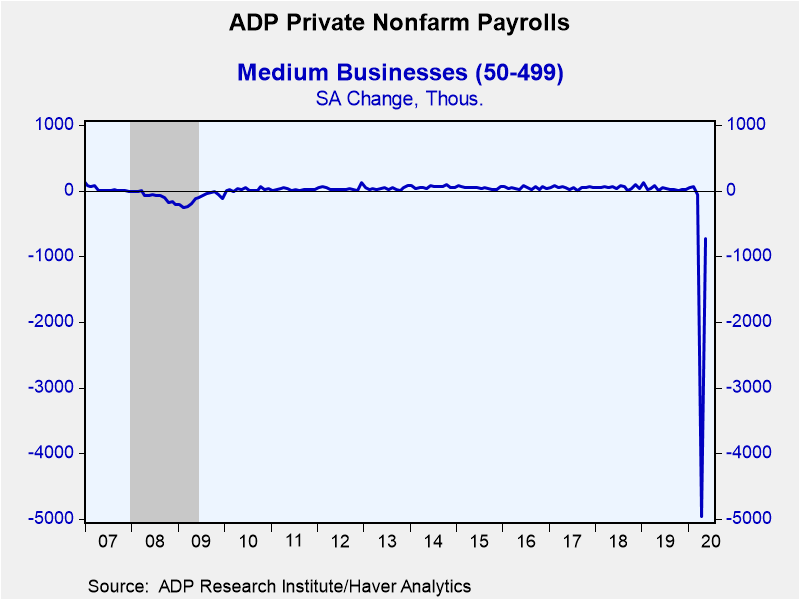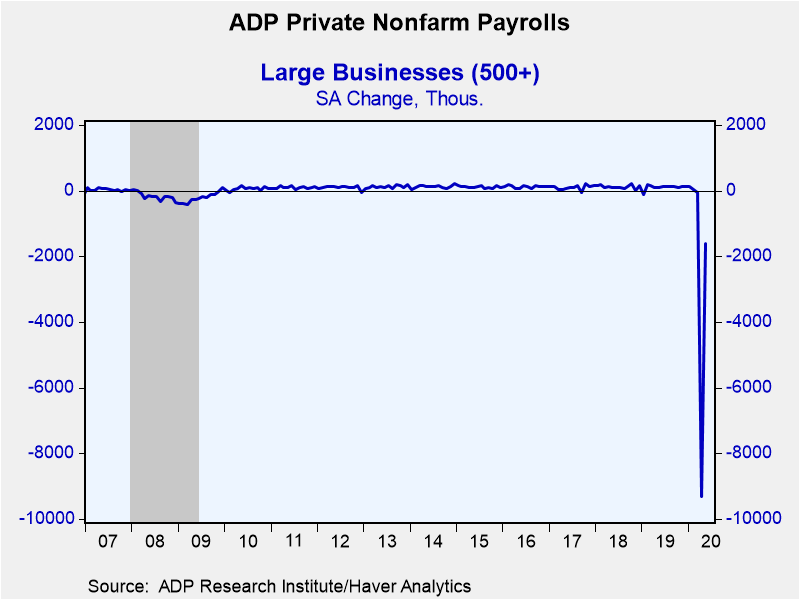 Global| Jun 03 2020
Global| Jun 03 2020U.S. ADP Nonfarm Private Payroll Declines Moderate During May
by:Tom Moeller
|in:Economy in Brief
Summary
• Monthly decline follows record drop in April. • Employment drops in all sectors. • Factory payrolls remain notably hard hit. Job market weakness continued last month, although the rate of decline moderated versus April. The ADP [...]
• Monthly decline follows record drop in April.
• Employment drops in all sectors.
• Factory payrolls remain notably hard hit.
Job market weakness continued last month, although the rate of decline moderated versus April. The ADP National Employment Report indicated that nonfarm private payrolls during May declined 2.760 million (-16.6% y/y) following a 19.557 million April shortfall, revised from -20.236 million. The March decline was revised to -302,000 from -149,000. The latest figure compared to a 9.000 million decline expected in the Action Economics Forecast Survey. The ADP report is based on data through May 12.
Large payrolls again were notably hard hit and declined 1.604 million (-15.3% y/y) after falling 9.319 million in April. Medium-sized payrolls followed with a 722,000 drop (-18.3% y/y) following a 4.962 million shortfall. Small payrolls weakened 435,000 (-17.6% y/y) after falling 5.276 million in April.
Within industry sectors, employment amongst goods-producing firms weakened 794,000 (-14.9% y/y) last month after a 2.356 million fall. The size of construction sector payrolls eased 22,000 last month (-12.3% y/y) following an outsized 976,000 April drop. Factory sector employment declined 719,000 (-16.3% y/y) after falling 1.330 million. Employment in the natural resource & mining sector eased 2,000 (-16.2% y/y), continuing a long pattern of decline.
Employment in the private service sector fell 1.967 million (-16.9% y/y) after declining 17.201 million in April. An 826,000 decline (-13.6% y/y) in trade, transportation & utilities, the largest sector, was accompanied by a 250,000 decline (-10.0% y/y) in employment in the professional & business services sector. A 105,000 decline (-46.0% y/y) in the leisure & hospitality area followed a huge 7.654 million drop. Employment in the financial services sector weakened a fairly steady 196,000 (-4.1% y/y). Education & health services jobs fell 168,000 (-9.5% y/y) which added to an outsized 2.543 million decline in April. Financial activities payrolls weakened 196,000 (-4.1% y/y) following a 262,000 shortfall. Information sector payrolls declined 115,000 (-13.5% y/y).
The Automatic Data Processing Research Institute survey covers 411,000 companies and includes about one-fifth of U.S. private payroll employment. The data are processed by Moody's Analytics Inc., then calibrated and aligned with the BLS establishment survey data. The ADP data cover private sector employment only.
The ADP National Employment Report data can be found in Haver's USECON database. Historical figures date back to 2001 for private employment and the industry breakdown, and 2005 for the business size breakout. The expectation figure is available in Haver's AS1REPNA database.
| ADP/Moody's National Employment Report | May | Apr | Mar | May Y/Y | 2019 | 2018 | 2017 |
|---|---|---|---|---|---|---|---|
| Nonfarm Private Payroll Employment (m/m chg, 000s) | -2,760 | -19,557 | -302 | -16.6% | 1.5% | 1.8% | 1.7% |
| Small Payroll (1-49) | -435 | -5,276 | -187 | -17.6 | 0.2 | 0.6 | 1.1 |
| Medium Payroll (50-499) | -722 | -4,962 | -65 | -18.3 | 2.0 | 2.0 | 1.9 |
| Large Payroll (>500) | -1,604 | -9,319 | -50 | -15.3 | 1.9 | 2.3 | 2.0 |
| Goods-Producing | -794 | -2,356 | -32 | -14.9 | 1.6 | 2.9 | 1.8 |
| Construction | -22 | -976 | -26 | -12.3 | 2.7 | 4.1 | 3.7 |
| Manufacturing | -719 | -1,330 | -3 | -16.3 | 1.0 | 1.9 | 0.8 |
| Service-Producing | -1,967 | -17,201 | -270 | -16.9 | 1.5 | 1.6 | 1.7 |
Tom Moeller
AuthorMore in Author Profile »Prior to joining Haver Analytics in 2000, Mr. Moeller worked as the Economist at Chancellor Capital Management from 1985 to 1999. There, he developed comprehensive economic forecasts and interpreted economic data for equity and fixed income portfolio managers. Also at Chancellor, Mr. Moeller worked as an equity analyst and was responsible for researching and rating companies in the economically sensitive automobile and housing industries for investment in Chancellor’s equity portfolio. Prior to joining Chancellor, Mr. Moeller was an Economist at Citibank from 1979 to 1984. He also analyzed pricing behavior in the metals industry for the Council on Wage and Price Stability in Washington, D.C. In 1999, Mr. Moeller received the award for most accurate forecast from the Forecasters' Club of New York. From 1990 to 1992 he was President of the New York Association for Business Economists. Mr. Moeller earned an M.B.A. in Finance from Fordham University, where he graduated in 1987. He holds a Bachelor of Arts in Economics from George Washington University.










